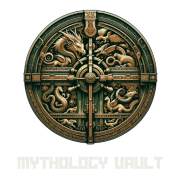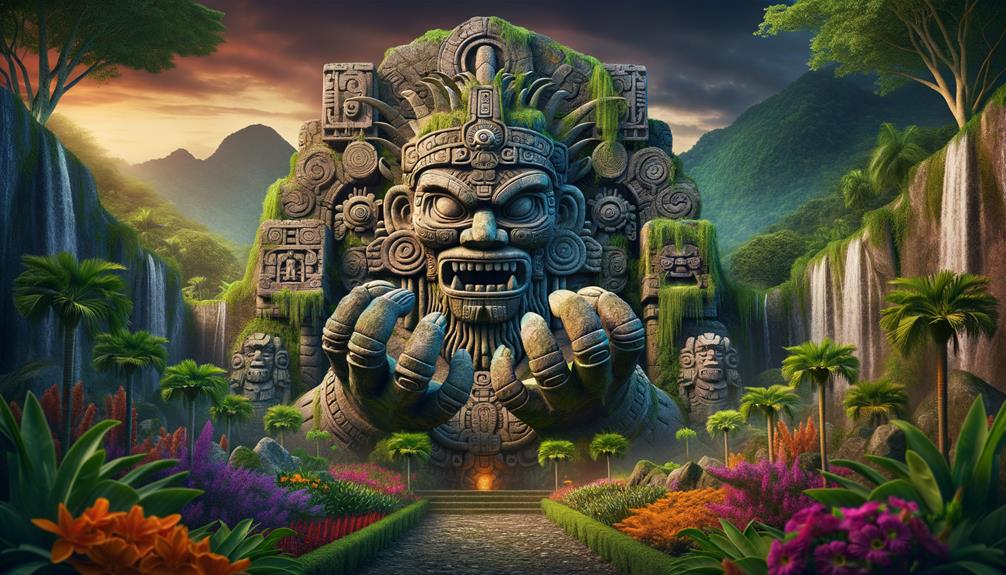The myth of Tlaltecuhtli, the Earth Monster Deity, transports us to a dramatic cosmic narrative of struggle and rebirth. Emerging from primordial waters, Tlaltecuhtli's dismembered body forms the very fabric of the world – an archetypal pattern mirroring creation through sacrifice. This deity's insatiable thirst for hearts and blood, appeased through rituals, reinforces the Aztec belief that life springs from perpetual cycles of death and renewal. Yet, beneath her fearsome visage of sharp teeth and skulls, profound meanings lurk, awaiting our exploration.
The Tlaltecuhtli Myth
The Tlaltecuhtli myth unveils the cosmic clash between creation and destruction as Quetzalcoatl and Tezcatlipoca engage in battle against the earth monster Tlaltecuhtli. Her dismembered body forms the landscape of our world. This myth reflects the pivotal nature of existence in Aztec cosmology. Tlaltecuhtli, depicted as a monstrous figure, represents both the birth of life and its annihilation. Her defeat by Quetzalcoatl and Tezcatlipoca, two central Aztec deities, symbolizes the transformation required for the world's genesis.
Tlaltecuhtli's story doesn't conclude with her defeat. She demanded human sacrifices to bear fruit and cease crying out in anguish. This need for blood offerings underscores her role in Aztec rituals and fertility. The Aztecs believed she devoured the sun each night, a fearsome act requiring further human sacrifices to ensure the sun's return. This cyclical destruction and rebirth are central to understanding Tlaltecuhtli's place in the Aztec creation myth.
Her portrayal, often squatting with multiple mouths spouting blood and adorned with human skulls, vividly captures her insatiable appetite for blood offerings. Tlaltecuhtli's myth encapsulates the incessant cycle of life, death, and rebirth in Aztec belief.
Role in Aztec Creation
From the chaos of ancient oceans emerged Tlaltecuhtli, a powerful Earth Monster deity in Aztec mythology. Quetzalcoatl and Tezcatlipoca dismembered Tlaltecuhtli, transforming her body into the world's foundations – mountains, rivers, and valleys. This creation myth illustrates the Aztec belief that life springs from sacrifice and destruction.
Tlaltecuhtli's role underscored the balance between nourishment and turmoil in Aztec cosmology. Her torn flesh formed the fertile earth, yet it demanded continual blood offerings to sustain balance and fertility. The myth reflects nature's cyclical pattern of life and death.
Debates surround Tlaltecuhtli's gender identity, adding richness to her multifaceted nature. As both life-giver and devourer, she embodied the contradictory yet intertwined forces behind creation and destruction.
Rituals and Sacrifices
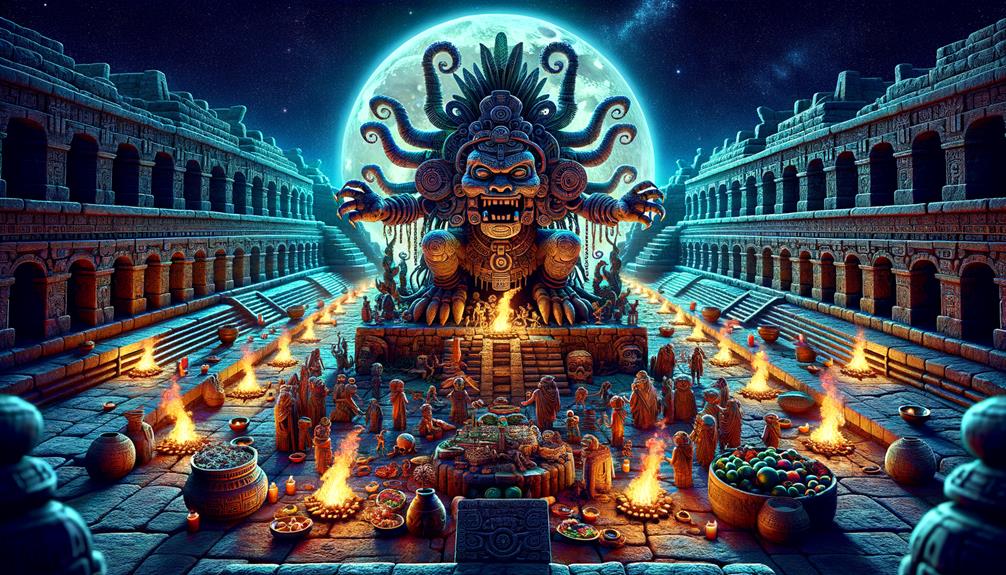
The Aztecs believed sustaining life necessitated profound blood rituals and sacrifices. Tlaltecuhtli, the earth monster goddess, craved hearts and blood to nourish crops and prevent eternal darkness during solar eclipses. Intense rituals with human offerings aimed to please her and secure favor.
Warriors invoked Tlaltecuhtli before battles, seeking her might. Midwives called upon her for challenging births, highlighting her role in fertility rituals vital for community survival. Through sacrificial acts, the Aztecs maintained cosmic balance and facilitated life's renewal, placating the formidable Tlaltecuhtli.
Artistic Representations
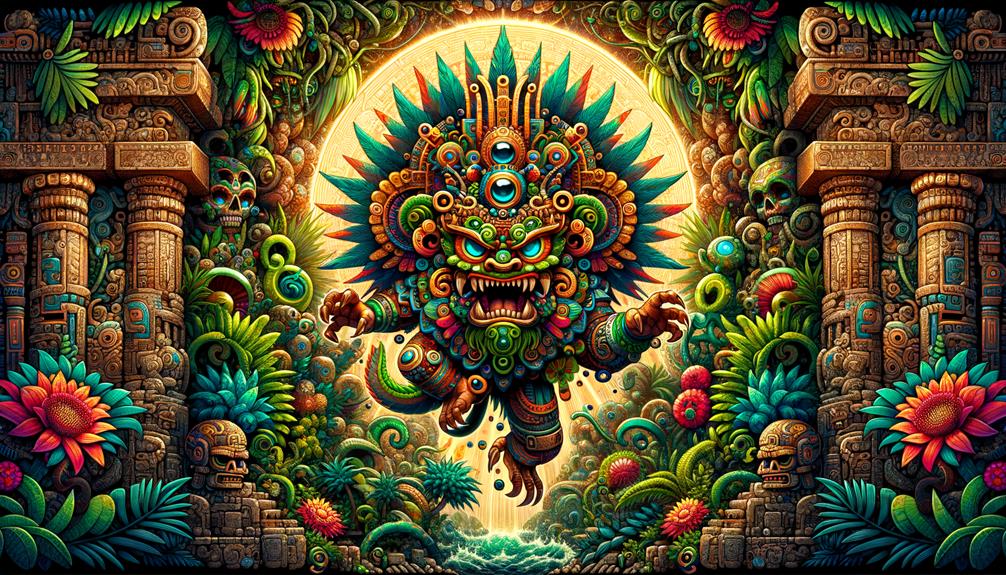
Exploring the artistic depictions of Tlaltecuhtli reveals a striking interplay of life and death. This primal earth deity manifests as a monstrous figure blending human and animal elements. With sharp teeth, and skulls adorning her body, Tlaltecuhtli embodies both creation and destruction.
Some artworks show her squatting menacingly, clutching a sacrificial knife or spewing blood from her mouth – vivid symbols of sacrifice and renewal. Occasionally represented as an alligator-like creature, her claws and fearsome appearance emphasize her role in nature's cycles.
Intriguingly, Tlaltecuhtli sculptures were often hidden from view, placed beneath temple cornerstones. This concealment speaks volumes about her enigmatic power governing fertility and death beneath the surface of the visible world. Her imagery captures the eternal dance of life emerging from death, embodying the primal earth forces that devour to regenerate.
Discovering the Monolith
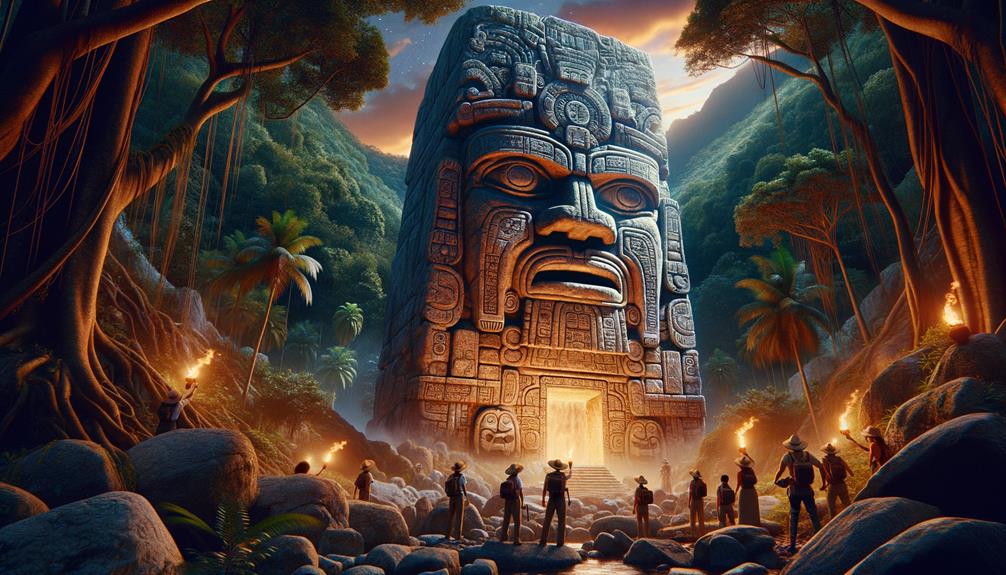
In 2006, uncovering the Tlaltecuhtli monolith at Templo Mayor felt like stumbling upon an ancient mythological chapter, revealing the awe-inspiring and fearsome Earth Goddess. The excavation in Mexico City marked the discovery of one of the largest Aztec monoliths ever found, weighing nearly 12 tons and carved from pink andesite. This was no ordinary stone; it vividly embodied Tlaltecuhtli, the monstrous earth deity, depicted in a squatting position.
The monolith surfaced in four broken pieces, yet each fragment told a compelling story. Once reassembled, it displayed a fearsome skull, a skirt of bones, and a river of blood—confirmation of its vivid red, white, black, and blue paint. The year glyph for 10 rabbit (1502 CE) clutched in the Earth's grasp linked this discovery to a specific moment in Aztec history. Now, reassembled and exhibited at the Templo Mayor museum, it stands as a colossal reminder of the Aztecs' mythological imagination.
| Aspect | Details |
|---|---|
| Discovery Year | 2006 |
| Location | Templo Mayor in Mexico City |
| Composition | Pink andesite, vividly painted |
| Museum Exhibit | Displayed at the Templo Mayor museum |
This monstrous monolith invites us to journey into the Aztec cosmic mythology.
Frequently Asked Questions
What Is Tlaltecuhtli the God Of?
Tlaltecuhtli, the Aztec goddess, personified our planet's unquenchable thirst for human life to maintain the balance between existence and nonexistence, a primal force reflected through ritual sacrifices. She embodied the earth itself, her relentless hunger mirroring the mythological cosmos' pivotal need for restoring equilibrium between creation and destruction.
Who Is the Earth Monster According to Aztec Culture?
In the heart of Aztec traditions, Tlaltecuhtli, the Earth Monster, embodies the cycle of creation and destruction. Dismembered, Tlaltecuhtli's body forms the world itself, its insatiable hunger demanding human sacrifices to sustain the cosmic balance between life and death—a powerful metaphor for nature's unending rhythms.
What Are the Symbols of Tlaltecuhtli?
When I first saw Tlaltecuhtli, her flint knife clenched between teeth struck me most. This visceral image connects her to sacrificial rites, representing the cycle of life, death and fertility so pivotal in Aztec belief systems. The knife's sharp edge and blood-stained appearance powerfully evoke the darker aspects of agricultural renewal through human offerings to the earth. Yet Tlaltecuhtli also nurtures with her sacred feminine energy. Her symbolic duality captures the complexities surrounding ancient fertility cults and humanity's primal relationship with nature's cyclical rhythms.
Who Is the Earth Goddess in Aztec Legend?
Tlaltecuhtli, the Aztec Earth Goddess, personifies the cycle of life through creation and destruction. Her myth mirrors archetypal themes of rebirth, underscoring the sacrifices made for continuity. The hero's journey unfolds as her legend unfurls.
Who Is the Earth Monster?
The earth monster, an embodiment of creation and destruction, represents life's cyclical nature – birth and death. In Aztec mythology, this entity's dismemberment forms our world, reflecting the archetypal notion of sacrifice enabling rebirth and renewal.
